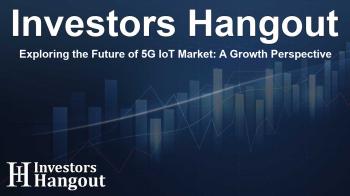Exploring the Future of 5G IoT Market: A Growth Perspective

The Rise of the 5G IoT Market
The 5G IoT market is on a remarkable trajectory, poised to grow significantly. As we delve into the recent analysis, expectations indicate that the market size, valued at USD 10.76 billion in recent years, is expected to soar to USD 208.48 billion by 2032. This growth represents a compound annual growth rate (CAGR) of 39% throughout the forecast period, unveiling a promising landscape for tech enthusiasts and industry players alike.
Transformational Impacts of 5G IoT
The impact of integrating 5G technology with the Internet of Things (IoT) is transformative, revolutionizing connectivity and communication. Enhanced speed, reliability, and scalability offered by 5G networks allow real-time data exchange across various sectors. This trend is particularly evident in industries such as autonomous vehicles and smart city initiatives, where low latency connectivity plays a critical role in improving operational efficiencies.
Sector Innovations Fueling Demand
Several sectors including healthcare and industrial automation are adopting 5G IoT solutions. For instance, telehealth innovations and robotic surgeries are enabled by ultra-reliable low-latency connectivity, which ensures timely intervention and monitoring. The trend emphasizes the increasing reliance on technology, showcasing how 5G is empowering healthcare professionals with advanced tools for patient care.
The Role of Leading Companies
Major players in the market are consistently innovating to capitalize on these trends. Companies like AT&T, Verizon, and Huawei are leading the charge, enhancing their offerings to cater to growing market demands. Their initiatives include developing advanced connectivity solutions and platforms tailored to various industrial needs, thereby fostering growth within the sector.
Market Segmentation and Growth Drivers
The 5G IoT market is segmented by component, organization size, network type, and end-user. According to recent data, hardware dominates the market, accounting for significant revenue shares. The rapid development of diversified IoT devices showcases the importance of robust infrastructure in facilitating the growth of the 5G IoT ecosystem.
Impact of Manufacturing Sector
The manufacturing sector, capturing around 22% of revenue, demonstrates considerable adoption of 5G-driven IoT solutions. Innovations in smart manufacturing processes allow for enhanced operational performance and real-time data processing, empowering businesses to innovate further. Companies such as Siemens have spearheaded the integration of 5G IoT solutions in their operations, enabling smarter, more efficient manufacturing systems.
Regional Insights and Global Dynamics
Globally, the Asia Pacific region is the frontrunner in the 5G IoT market, holding approximately 33% market share. This leadership is largely influenced by significant investments in 5G infrastructure by countries like China and India. Notably, initiatives in China, which involve massive investments in 5G technologies, are further propelling this growth.
North America's Rapid Growth Potential
North America, however, is projected to demonstrate the fastest growth rate in the coming years, with expectations of a CAGR of 41.02%. This growth is fueled by advancements in smart warehousing and field services, directly linked to the implementation of 5G technologies in various industrial applications.
Current Trends and Future Outlook
Recent partnerships and technological advancements affirm the robust nature of the 5G IoT market. Notable collaborations, such as those between Ericsson and local telcos, are validating documentation processes for enhanced operational functionalities. These partnerships aim to provide comprehensive solutions catered to the specific needs of regional markets, thereby fostering a collective growth environment.
Looking Ahead: A Connected World
The trajectory of the 5G IoT market illustrates a world increasingly reliant on connectivity. As industries adopt 5G technology, both the challenges and opportunities will evolve. Companies at the forefront of this technological revolution are well-positioned to shape the future landscape of smart connected devices, cementing their roles as leaders in this burgeoning arena.
Frequently Asked Questions
What is the expected market size for the 5G IoT market by 2032?
The market is projected to reach USD 208.48 billion by 2032.
Which sectors are primarily influencing the growth of the 5G IoT market?
Key sectors include healthcare, manufacturing, autonomous vehicles, and smart cities, driving demand for advanced connectivity solutions.
What companies are leading the 5G IoT advancements?
Major companies include AT&T, Verizon, Huawei, and Siemens, which are developing innovative solutions to enhance their market presence.
Which region is leading in the 5G IoT market?
The Asia Pacific region is currently the leader in market share, primarily driven by significant investments in infrastructure in countries like China and India.
What key trends should we watch for in the 5G IoT market?
Trends include partnerships for technology validation, growth in smart manufacturing processes, and increasing reliance on telehealth solutions.
About Investors Hangout
Investors Hangout is a leading online stock forum for financial discussion and learning, offering a wide range of free tools and resources. It draws in traders of all levels, who exchange market knowledge, investigate trading tactics, and keep an eye on industry developments in real time. Featuring financial articles, stock message boards, quotes, charts, company profiles, and live news updates. Through cooperative learning and a wealth of informational resources, it helps users from novices creating their first portfolios to experts honing their techniques. Join Investors Hangout today: https://investorshangout.com/
Disclaimer: The content of this article is solely for general informational purposes only; it does not represent legal, financial, or investment advice. Investors Hangout does not offer financial advice; the author is not a licensed financial advisor. Consult a qualified advisor before making any financial or investment decisions based on this article. The author's interpretation of publicly available data shapes the opinions presented here; as a result, they should not be taken as advice to purchase, sell, or hold any securities mentioned or any other investments. The author does not guarantee the accuracy, completeness, or timeliness of any material, providing it "as is." Information and market conditions may change; past performance is not indicative of future outcomes. If any of the material offered here is inaccurate, please contact us for corrections.
